Starting in mid-March, I went on an intellectual camping trip with 226 university students. We decided (a generous expression) to take our learning remote. How did it go? What did I learn? What worked?
As with all things strategy, it involves trade-offs and using your strengths to an advantage. What makes remote learning more flexible, accessible, interactive, and better? Let’s do that. Copycatting the competition (in this metaphor, “local classroom”) is a path to mediocrity, no bueno.
Activities which seemed to work for me:
- Clarify logistics. It’s easy to get lost in the hyperlinks, surveys, assignments, expectations
- Record lecture content, send out early
- Send out PDF print outs of the recorded content
- Use live (let’s call it ZOOM) time for discussion, interaction
- Show the discussion questions upfront
- Create comfort by consistency of routines, norms, process
- Bling out the online experience with polls, chats, and breakouts
- Do as Satya Nadella recommends for new hires: “bring energy and clarity”
- Triple the # of ways for students to engage / class participate with the content
- Get feedback daily; if something’s not working you need to correct daily
- Debrief the class by email (or LMS) and post the video recording
- Have fun
Remote learning worked
Okay, this might surprise some, but I thought it worked fine. It’s got a lot of potential, and in many ways, we’ve been itching for a little bit of change. Students attended the online sessions. They did the work, learned a lot, wrote great exams. They “learned how to learn” and had some of the cathartic intellectual struggle. For the final exam, it was open-book and I was genuinely surprised at the quality of the answers. The students evaluations of the course came back above my 3 year average, so far so good. Here’s to learning.
Yes, of course, lots to improve
As with anything new, there is a learning curve (yes: labor productivity from the doubling of production). Many things which would make it smarter, easier, and more fun. Earnestly, I believe we will get there. However, if we want to kvetch:
- The syllabus was designed for in-person, so a mid-semester switch to fully online = not pretty
- Students had the option to take the class “pass / no pass” = lots of grading uncertainty
- All team projects got converted to easier individual ones = lots of logistics and explaining
- Student evaluation is difficult to do remotely vs. proctored classroom setting
- Class participation is still doable – but needs clear expectations setting, and student comfort
- Course content, class size, learning objectives, teaching pedagogy are all different
- Students were overseas (+/- 12 hour time zone difference); some home environments not good
Agreed: online is not in-person + a PC screen
Taking traditional, in-person content (no matter how well-organized, curated ) and playing it for the audience on video is likely to underwhelm. Watch a concert vs. go to a concert. Since the “experience” has largely been stripped out of recording, it needs to be augmented in other ways. Making it experiential – remotely – is THE challenge.
The following input is a n=1. Also, please see what the learning titans say about remote learning (affiliate links):
- Ken Bain’s, What the Best College Teachers Do
- Barbara Oakley’s A Mind For Numbers
- Doug Lemov’s Teach Like a Champion
Think outside of the syllabus
There are so many differences between local classroom and remote learning, that it only makes sense to re-think, re-do, re-charge the content. With so many constraints gone, what are the possibilities?
- Freedom of time. Perhaps that most liberating aspect is the time freedom. For students, they can watch the recorded content, now, later, or in pieces/parts. For teachers, we can (re)use the content here/there/everywhere
- Freedom of frequency, medium, place. Students can watch, or listen again. They can watch on their laptop, or phone. We don’t have to coordinate 70 calendars to make 75min of magic happen
Flip the classroom
For anyone who is a fan of Khan Academy, they know what this means. Your situation may vary, but my undergraduate strategy classes are 28 sessions x 75 minutes. For the 75 minutes, I recorded 30 min of lecture content (listen to me talk AT you) and 45 min of pure facilitated discussions. This decision to “flip the class” has a cascade of implications:
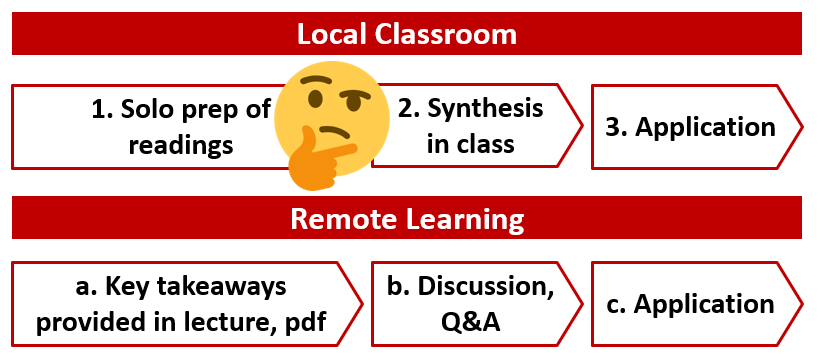
#1 – students read through a good bit of material with some guiding questions. We plan and expect some mental struggle. Bring your questions to class. #2. Provide printed handouts in class; these are like worksheets with 5-10 well placed __________ for us to fill in as we go. Massive synthesis. #3 application – putting it to good use via papers, exams, surveys, online discussions etc. .
a – For remote learning, this looks different. I give the PDF prints and recorded lectures in advance, before we get together as a group. In other words, they’re getting the highlight reel b – Everyone’s read the Spark notes already, so this time is friendly, less edgy. It’s a lot less threatening, and generally a feel-good discussion, with some Q&A. c = 3.
1 Page summary of these 12 points:
Here’s how I approached my 4 classes this semester (3 strategy, 1 consulting). I put them into 3 buckets (hat tip: KI).
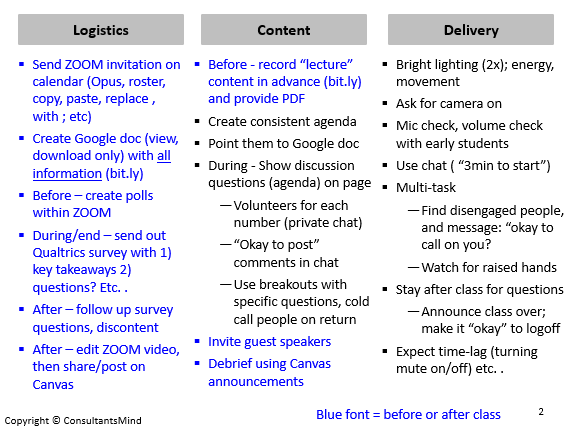
1) Clarify the logistics
- Super boring, super important. Create a central place (for me a Google doc) which has a running list of the schedule, instructions, hyperlinks and any other announcements. Put it in one place. Create a tinyurl or bit.ly link, so that all participants know where to go. www.bit.ly/LookHereNow
- Google Doc is a kinda a new thing for me, and it’s straight awesome. You can see that I was adding on it almost daily, with links to the PDF and Videos that students would read/watch prior to ZOOM
- “I got confused, did not know where to look, what to do, how to do it.” Six-sigma this defect out
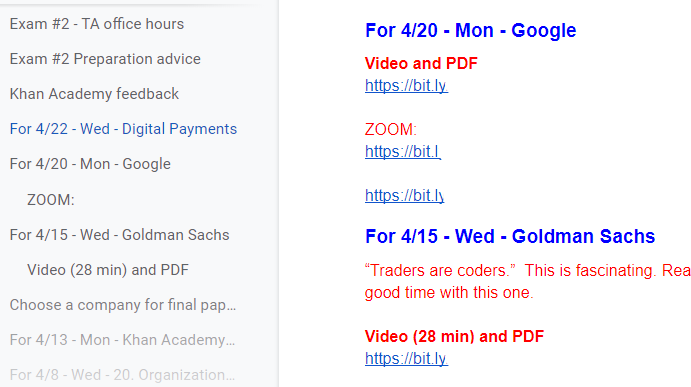
2) Record lecture content, send out early
I didn’t have these recordings already. So, I recorded the video (at home) with bright lights, then posted (look: Google doc) several days before the corresponding ZOOM class. Record, share.
3) Send out PDF early, with recordings
Local class: Typically, I don’t provide hand-outs until the day of class. Why? I want the students to read the original cases, research, websites, 10K, (20-30pgs) first. . .develop their own opinions.
Remote learning: Students get these PDF at the same time as the recording. My handouts are consulting-quality (self praise? yes, kinda) and essentially spoon-feed the “buckets” needed to understand the topic. These are spark notes. They can follow along, take notes. I actually advise students to “hack” by watching the video FIRST, then skimming the source material second. Note: this is how executives do it.
4) Use live (e.g., ZOOM) time for discussion, interaction
I expect students to speak 50% of the time+ in the local classroom. For ZOOM calls, I try to target 70%. No one wants to stare at a screen and watch other people talk – unless it’s a Netflix comedy special. With my acquiescence (GMAT word, grudging acceptance) of the recordings (#2) and PDF (#3), I also expect students to be prepared. Cold calls are still in season. In a 45 min session, I’d like to target 15-20 students speaking up, with another 10+ students giving comments by chat. This is precious time to create some humanity and serendipity – cherish this time.
Overseas students: For my students in India, China, Korea, Europe, etc. . set up a separate make up session for them on Friday morning at 8am EST. It was a two-for-one session (covering topics from two classes).
5) Show the ZOOM discussion questions upfront
After some experimenting, I chose to drive the entire 45 min discussions on a list of questions. No fancy videos, PowerPoint slides, or presentation. Nope. Here’s what we are going to talk about – based on the assumption that you did the work. . .let’s get started. Here’s a screenshot of the 1 page I used for our discussion of the Digital Transformation at Goldman Sachs. If your curious, it’s largely based on this interview with Marty Chavez here.
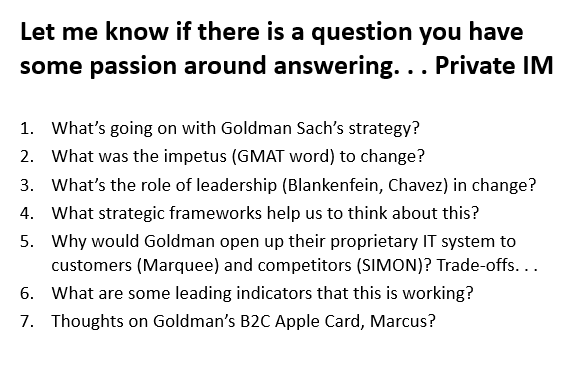
There were many benefits to this approach:
- Signals to the audience where we were headed (this is not a hostage-taking lecture)
- Allows students to discretely volunteer; they message me with the # they want to answer
- Provides the topic # that I can refer to throughout the session
6) Create comfort by consistency of routines, norms, process
I am a creature of habit and so are many of my students. So, whatever we can do to create a sense of consistency, comfort, and flow – is both appreciated and helps. We get into a virtual, digital rhythm faster. For me:
- Join the call early, play music and “chat” with the early joiners
- Start with announcements, logistics, and direct their attention (again) to the Google doc
- Show the discussion questions, ask them to message me if they want to volunteer with a specific question
- End the meeting on time, and stick around for 30 minutes to answer questions, and chat on the content
- Send out a debrief announcement (think: meeting minutes) and also a survey to get feedback after every class
7) Bling out the remote learning experience
Key question: what can a facilitator do to keep people engaged, alert, learning?
- Polls: ZOOM has a function where you can poll people in the middle of the session. This is no different from when you ask, “okay, raise you hand if you agree with the author.”
- Chats: For all the discussion questions, I tell the audience (and specifically folks who are shy) to type in their answers into the chat. Yo – people type quickly, and it’s almost at the speed of a verbal comment
- Breakouts: ZOOM allows you to randomly split up the group into various sizes. NB: the teams need to be very clear on what the task is. . which questions they should be discussing, answering
8) “Bring energy and clarity” – Satya Nadella, CEO MSFT
No way around this one. . . For remote learning to work, we – teachers, facilitators, communicators – need to be 30% more energetic and 30% more clear. Low-energy & clouded is not what we want. Satya Nadella video here.
Some easy things:
- Get some bright lights; record yourself and test the audio & video quality
- Ask students to turn on their cameras, “Cameras on, if okay. . .”
- Stand up and use the (video) space; move closer / farther from the camera
- Gesticulate (GMAT for move) a bit more than you normally might
- Pause – use silence – this will dramatically snap people’s attention
Some skillful things:
- Cue up several students who you can call on (think about a performer who “works the room” before the show)
- Direct message students who don’t have their camera on and simply text, “What did you think of the reading?”
9) Triple the # of ways for students to engage
Remote learning is a continuous process, not discrete task. It’s not a “go to class” data point, it’s a flow of recordings, readings, group sessions, team discussions, chats, comments, presentations. Some ideas might include:
- Invite guest speakers. People are largely trapped in their homes right now. Perfect time to call in favors and have people “drop in” during your class sessions
- Ask students to record video. Everyone is an indie film maker now. Have them record, then others can watch
- Continue discussions started in ZOOM class, with online chat boards (think: Learning Management System)
- Create 3 page presentations. Challenge students to create short, executive summaries of things learned to date
- Use office hours aggressively.This format saves teacher’s time. This surplus can be used for 1-on-1 ZOOM chats.
10) Get feedback every session
This might sound onerous, and I guess it is. . . After every class, I had students fill out a 2 question survey:
- The first question: What is your key takeaway from today’s content?
- The second question varied a good bit:
- What can we do to make this a better learning experience for you?
- Are you planning to take this class pass/no pass or graded?
- What did you think of the guest speaker?
Feedback is a gift. This provides a “release valve” for unmet needs, frustrations, and comments. In a local classroom, a student might walk up after class and mention something, or show you their boredom at a redundant exercise. However, remotely – we need to create safe, almost mundane ways to collect critical feedback. Culture trumps strategy.
11) Debrief email after each ZOOM session
Just like we do in the corporate world, gotta send out “meeting minutes” after the class. What were the key takeaways, action items and announcements? We use Canvas (LMS, learning management system), but this is essentially a big email list serve. Adults need to reflect on their learning, and these debriefs help to remind, nudge, and crystallize. The video recording of the ZOOM session is mentioned in these debriefs, and (of course) in the trusty Google Doc.
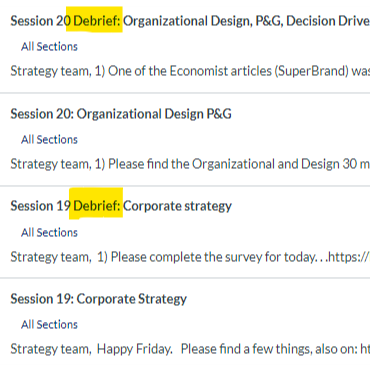
12) Have fun
As a bonus. Have fun. I continually tell students to do the hard things. Follow their curiosity. Push themselves etc. . . Well, it’s time for me to “eat my own cooking.” Wisdom is taking your own advice, right?
Thankfully, teaching is teaching
Thankfully, a lot about teaching is the same too. Demonstrating expertise. Making it easy to learn. Framing content within the student’s existing knowledge base. Setting high expectations. Being fair. Providing new channels for learning. “Learning how to learn” and “Think about their thinking”. Pushing them to do more. Having strong opinions, loosely held. Have fun, friends.

This is terrific, thank you.
I am working with consultant teams who will be working remotely and do not know each other at the start of the project. If you have ideas on how to get teams to “gel” smoothly and quickly when they are working remotely, that would be most appreciated.
Judy, that’s such a good question. It’s something I will be dealing with in my next cohorts. With no in-real-life relationship to base this on. . .how to create a culture of trust, and safe failing? I’ll report back later – but a few things come to mind: 1) survey up front with questions – so you (the facilitator) know something about the people 2) breakout groups (pairs) where they get to know each other, then are asked to “introduce their new friend 3) give them a task . . . ambitious consulting-y types like to “get stuff done.” 4) oh, my. . . this is our homework, right?
This is a great post, thank you for sharing! As a high school teacher making this shift as well, I found myself doing much of what you listed here. I whole-heartedly agree about making it energetic and pushing the students – I feel that I had much more success than my colleagues (with high-school age students) by embracing that.
Yes, it’s a fun pedagogical challenge. . how to engage students – meet them where they are – and connect. It’s possible, believe that remote learning can be incredibly effective, scalable, and personal. . still working on it. . thanks for reading.